Certain names in the email marketing space stand out for their specialized offerings tailored to specific niches. Two such notable platforms are CM Commerce and Campaign Monitor.
Campaign Monitor, founded in 2004, serves a diverse range of industries, while CM Commerce (formerly Conversio), established in 2014, is primarily designed to meet the needs of ecommerce businesses with its specialized features.
The relationship between these two platforms is straightforward. CM Commerce is part of the Marigold group of companies, including Campaign Monitor. As a result of this affiliation, both platforms share a similar logo and name, and they complement each other in specific functions.
While platforms have many similarities, they are distinguished by their unique features.
When weighing your options between Campaign Monitor vs CM Commerce, it’s crucial to understand the distinct advantages each platform offers.
In this post, we’ll evaluate these tools on criteria such as ease of use, pricing, features, and customer support. Thus, we aim to comprehensively compare CM Commerce vs Campaign Monitor.
CM Commerce vs Campaign Monitor: A quick overview
CM Commerce, formerly Conversio, is a big player in the email marketing space, particularly for ecommerce businesses.
In the Shopify App Store, CM Commerce holds a strong rating of 4.6 out of 5.Users highlight its specific ecommerce features, ease of use, and diverse functions.
While Campaign Monitor doesn’t have a separate rating on the Shopify App Store due to CM Commerce’s presence, it remains distinct. The platform maintains a strong reputation in the broader email marketing space.
Although both platforms might appear similar due to their common parent company, each has a unique focus. CM Commerce zeroes in on ecommerce, whereas Campaign Monitor provides a more generalized email marketing suite.
So, which tool aligns with your needs – Campaign Monitor or CM Commerce?
To help you decide, we’ll highlight the main contrasts between these two platforms. Then, we’ll delve into an in-depth, feature-by-feature comparison.
CM Commerce vs Campaign Monitor: Feature by feature
Both CM Commerce and Campaign Monitor offer unique capabilities. To determine which tool aligns best with your needs, we’ll compare them feature by feature.
Let’s dive in.
Ease of getting started
Both CM Commerce and Campaign Monitor offer a clear signup process.

CM Commerce’s onboarding is split into five steps. These steps help users set up brand themes, upload logos, and manage key functions. The platform has a standout gamification feature: users earn extra trial days for each onboarding task completed.
However, after initial signup, more details are needed. Users must verify their domain, enter the sender’s name, etc.
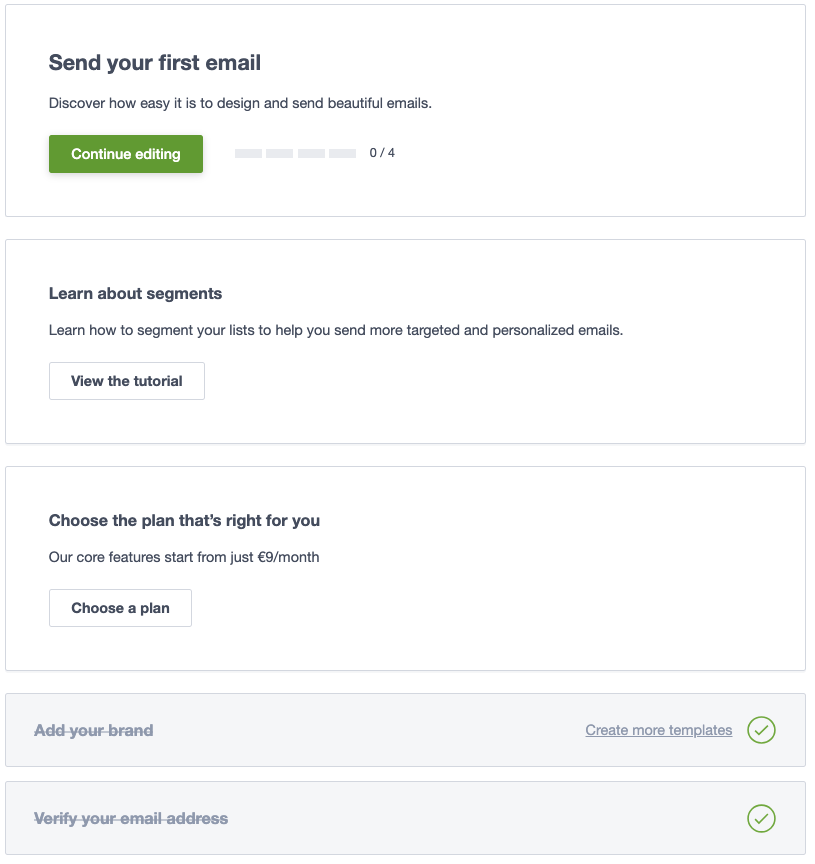
Similar to CM Commerce, Campaign Monitor’s interface, on the whole, is intuitive. Essential settings are easy to access, making the user experience generally positive.
CM Commerce emerges as the winner. Its unique onboarding approach ensures better user engagement and offers a clearer interface compared to Campaign Monitor.
Building an email campaign
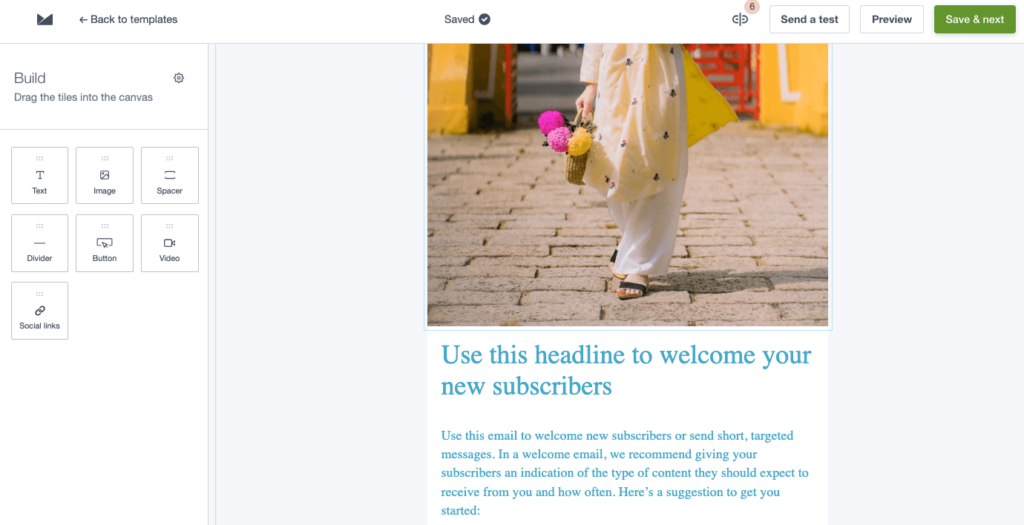
Campaign Monitor has a straightforward approach to setting up an email campaign. It provides prominent buttons for emojis, personalization, and subject line suggestions.
In contrast, the process of setting up email campaigns in CM Commerce feels less straightforward. Naming the campaign and determining the preheader can be challenging. This is because of their placement within the email builder settings.
Regarding design, CM Commerce adopts a unique builder design, which may not feel intuitive to all. It lacks ready-made templates, offering instead specific layout choices for certain events.
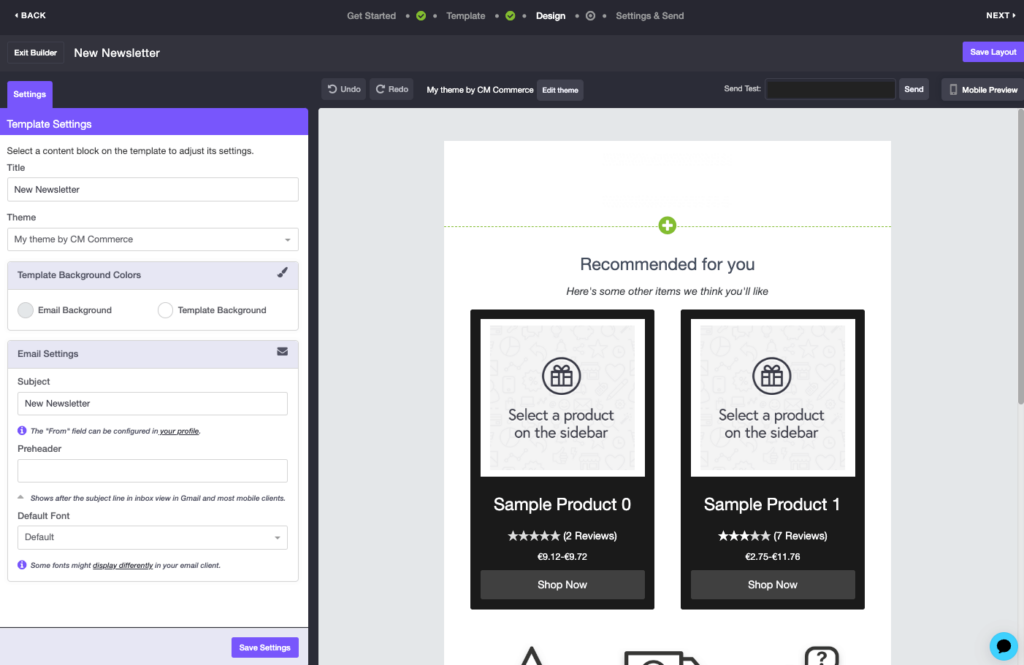
Conversely, Campaign Monitor uses a more standard interface—simple yet effective. Beyond basic elements like text, images, and buttons, it provides dynamic content blocks and a broad image library. However, some advanced features are exclusive to premium plans.
Integrating a brand logo is smoother with Campaign Monitor. CM Commerce permits logo addition during the onboarding but there is limited flexibility for changes after that.
Regarding the email templates:
- CM Commerce provides event-specific layouts, somewhat limited in scope.
- Campaign Monitor offers 120 diverse, contemporary templates.
While CM Commerce centers on standard email campaigns, Campaign Monitor extends its offerings to regular campaigns, A/B tests, and basic automation.
Both platforms support personalization, but Campaign Monitor’s approach is more user-friendly.
Diving into the distinct capabilities of each platform, CM Commerce impresses with a review feature. It lets users embed star ratings and testimonials. It also has shipping coupons and referral bonuses.
Campaign Monitor stands out in other ways. It lets email designers lock template sections to maintain brand consistency. Plus, there’s an element for social media sharing.
However, when considering CM Commerce or Campaign Monitor, note that both come with challenges:
- Campaign Monitor, though efficient, might lack the ecommerce-specific elements.
- While testing CM Commerce, we experienced occasional crashes and found its design somewhat dated. The platform also requires domain authentication for newsletters, which could pose challenges for less tech-savvy users.
Campaign Monitor takes the lead. Its intuitive builder and extensive template range set it apart.
Marketing automation
After evaluating CM Commerce, we give its user experience a rating of 3 out of 5. While it doesn’t offer drag-and-drop functionality, it does have controllers. These include delay, splits by different criteria, and stops.
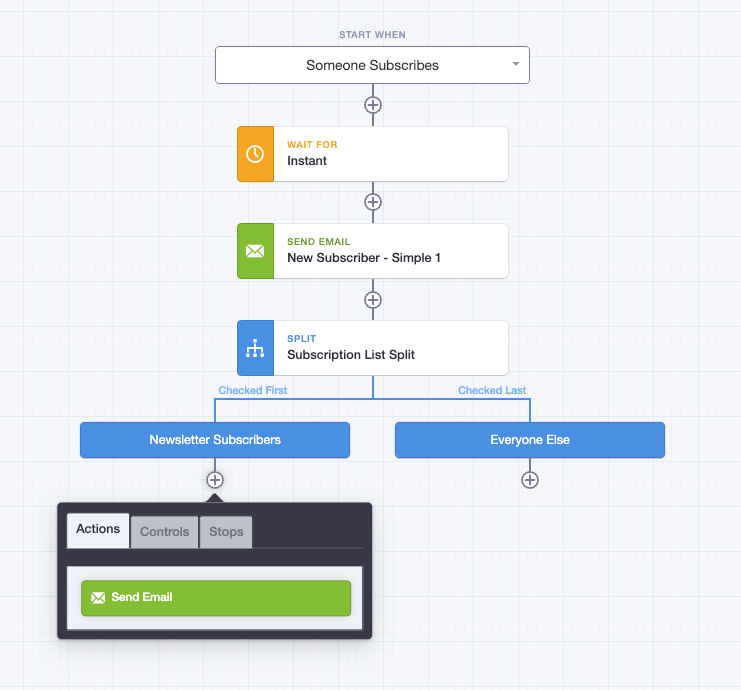
In contrast, Campaign Monitor opts for a more simple approach. It provides a basic and user-friendly interface.
Looking at pre-built workflows, CM Commerce stands out. It provides users with ready-to-use templates suitable for several business scenarios.
Additionally, there’s a separate tab featuring automation recipes and ideas. An added convenience is that CM Commerce’s automation workflows are copy-ready. This makes the process smoother for users.
On the flip side, Campaign Monitor’s offerings are more limited. It provides a singular pre-built workflow: a welcome email. Furthermore, its list of triggers for automation emails is somewhat restricted.
To break it down, here’s a brief overview of the available triggers:
CM Commerce offers the following triggers:
- Actions with orders
- When a cart becomes recoverable
- New subscriber sign-ups
- Creation of a coupon and more.
Triggers available in Campaign Monitor include:
- A subscriber joining a list
- Entry or exit from a segment
- Triggers tied to a specific date
- Actions in an online store, like paid orders or abandoned carts.
Many businesses today are keen on channel integration. But, it’s worth noting that neither CM Commerce nor Campaign Monitor currently supports integrating with other marketing channels.
While CM Commerce does offer some impressive features, there’s room to make the platform more user-friendly.
Campaign Monitor, meanwhile, could benefit from more diverse triggers. These could focus on the following:
- Email engagement
- On-site behavior
- Purchase patterns
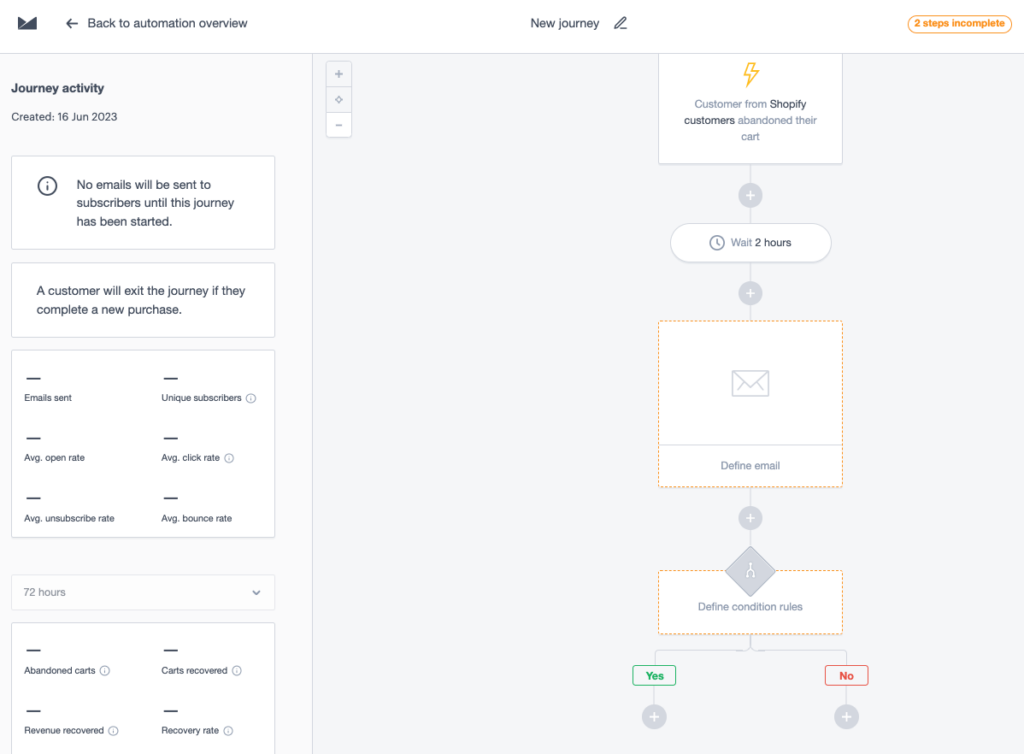
The platform would also gain from more ready-to-use solutions.
It’s essential to highlight Campaign Monitor’s offering of transactional emails. This feature can be a game-changer for small business owners.
CM Commerce takes the lead in this round. Its diverse set of triggers and copy-ready workflows give it an edge over the basic automation features of Campaign Monitor.
Signup forms and landing pages
CM Commerce offers a single design for both popups and embedded forms. Though user-friendly and easy to modify, it confines users to one layout.
Campaign Monitor, however, allows users more flexibility, letting users:
- Create a signup page
- Design a basic popup
- Integrate a form using code
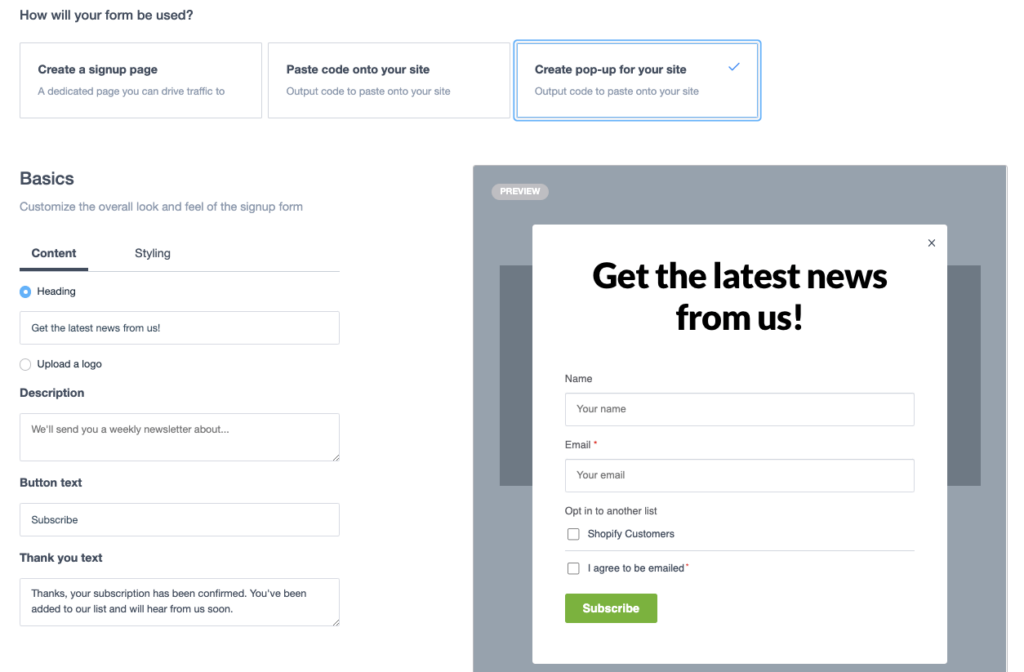
Yet, it doesn’t have a variety of templates, just offering a basic customizable form.
CM Commerce’s forms are modern but lack variety. Its user experience is acceptable, though adding custom fields can be challenging. Also, while it offers an opt-in email and a subscriber preference page, its settings could be more intuitive.
In contrast, Campaign Monitor offers simpler designs with minor customization, like adjusting fonts and button colors.
Regarding analytics, CM Commerce delivers insights on impressions and conversions for each form, a feature missing in Campaign Monitor.
CM Commerce doesn’t offer landing pages, while Campaign Monitor’s signup page doubles as a basic one. The latter also excels in customization simplicity.
In subscriber list management, CM Commerce categorizes subscribers into distinct segments and provides an easy import mechanism. However, it lacks a tagging feature.
Campaign Monitor, on the other hand, allows multiple list opt-ins and boasts an intuitive import process. Yet, accessing its provided segments within lists takes more work.
A limitation of CM Commerce is its signup form integration. Forms don’t automatically appear in stores. Users must manually embed the form or integrate it into Shopify themes, making it less convenient than other email platforms.
CM Commerce takes the lead. Despite both having challenges, CM Commerce gains a slight edge in form customization and analytics.
Segmentation
Which tool offers superior segmentation capabilities: CM Commerce or Campaign Monitor? It’s time to find out.
CM Commerce offers seven pre-defined segments, including:
- “At risk” repeat customers
- Active repeat customers
- First-time buyers
- Inactive repeat customers
- Potential buyers
- Prospects
- Repeat customers
In contrast, Campaign Monitor restricts engagement segments to its highest-tier plan users.
CM Commerce offers intermediate segmentation options. However, there’s potential for refining this to reach advanced segmentation levels.
On the other side, Campaign Monitor’s segmentation is on the basic side. Users looking for advanced email engagement insights need to opt for the Premier plan. This approach contrasts with many competitors that offer advanced segments in basic packages.
CM Commerce’s segment criteria include:
- Number of orders placed
- Total spending
- Time since the last order
- Products purchased or browsed
- Email engagement
On the other hand, Campaign Monitor offers:
- Subscriber details
- Limited custom fields
- Campaign activity
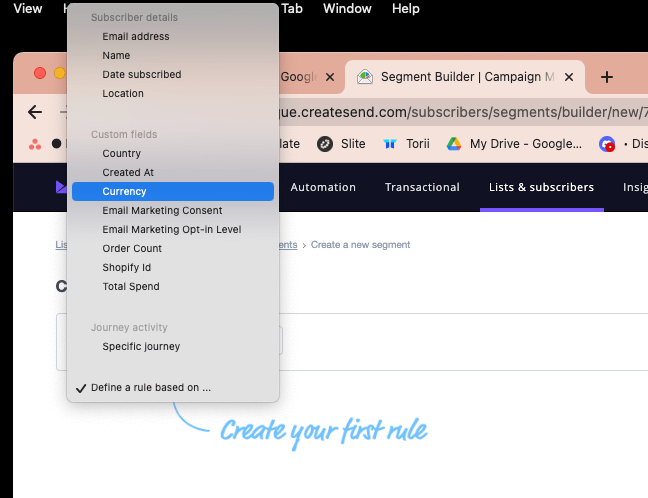
Both platforms have areas for improvement. CM Commerce could add criteria like average order value and abandoned cart data, along with tag functionality. Campaign Monitor lacks segmentation based on purchasing behavior.
CM Commerce takes the lead. It surpasses Campaign Monitor’s limited options with diverse segments and richer segmentation criteria.
Analytics
Analytics is essential for gauging the efficacy of email marketing campaigns. Let’s see how CM Commerce vs Campaign Monitor compare.
CM Commerce emphasizes ecommerce-centric insights in its analytics. Its reports showcase metrics such as:
- Email engagement
- Conversions
- Revenue
- Average order value
Such metrics are crucial for businesses aiming to link their email strategies with concrete business results.
On the flip side, Campaign Monitor offers a more basic approach to analytics. It highlights metrics like:
- Opens
- Clicks
- Delivery rate
- Bounces
- Insights into devices and location
However, it lacks data on revenue or order numbers. This absence can be a setback for businesses wanting to comprehend the ROI of their email campaigns.
Both platforms, though, have areas to enhance. CM Commerce could refine its analytics by adding:
- Geolocation
- Detailed device reports
- In-depth ecommerce insights
- Real-time analytics
Campaign Monitor, given its already foundational analytics, notably lacks ecommerce insights. This omission is crucial for online businesses trying to study the direct influence of their emails on sales.
CM Commerce is the winner. By highlighting email engagement, conversions, and revenue metrics, it offers a more in-depth analytics perspective compared to Campaign Monitor’s fundamental email metrics.
Customer support
Let’s compare the support offerings of Campaign Monitor vs CM Commerce.
CM Commerce provides:
- Email support
- Live chat support
This dual-channel approach benefits users desiring quick assistance or those wanting a documented conversation.
In contrast, Campaign Monitor offers:
- Email support.
- Phone support (24/5) for its paid subscribers, crucial for businesses desiring direct, personalized communication.
Regarding resources and tutorials, CM Commerce maintains a help center equipped with guides and instructions. This can be a self-help tool for users looking to troubleshoot issues or better understand features.
Campaign Monitor goes beyond with a rich resource offering that includes:
- A blog
- A dedicated help center
- An email marketing academy
- Webinars
This comprehensive resource library indicates the brand’s commitment to user education and empowerment.
Campaign Monitor wins in this round. With its extensive resource library and the addition of phone support for premium users, it provides a slightly more comprehensive support structure than CM Commerce.
Integrations
The ability of an email marketing platform to integrate seamlessly with other tools offers immense benefits to businesses. It allows brands to create streamlined and efficient workflows. Let’s assess how CM Commerce vs Campaign Monitor performs in terms of integrations.
CM Commerce integrates with major ecommerce platforms, including:
- Shopify
- Bigcommerce
- Woocommerce
These integrations are crucial for online retailers aiming to align their email marketing efforts with their sales channels.
Additionally, CM Commerce offers integrations with:
- Loyalty programs
- Signup forms
However, the overall scope of its integration list seems somewhat restricted, potentially limiting users in terms of functionalities.
On the other hand, Campaign Monitor boasts a comprehensive list of over 100 integrations. These cover:
- Ecommerce platforms
- List building tools
- CRM systems
- Advertising solutions
- Other vital business tools
This extensive variety gives users the flexibility to integrate a wide range of third-party applications, thus, enhancing their email marketing prowess.
Campaign Monitor takes the lead in this section. Its extensive integration list, serving a wide range of business needs, positions it as a more adaptable choice compared to the specialized integrations of CM Commerce.
Compatibility with other marketing channels
CM Commerce offers an integration tailored for businesses focusing on social media advertising, notably Facebook ads. This can be useful for brands looking to synchronize their email marketing with Facebook campaigns.
On the other side, Campaign Monitor is exploring SMS marketing. However, it’s worth noting that this feature is:
- Currently available only for USA-based users.
- Still in development with no clear framework for SMS quotas or pricing.
While Campaign Monitor’s SMS marketing offering isn’t completely efficient yet, its adoption shows the platform’s intent to broaden its scope.
It’s noteworthy that both platforms do not yet offer integrations with push notifications, Google Ads, or other key marketing channels—something competitors like GetResponse or Omnisend provide. Adding these features could make them more competitive in the market.
This round ends in a draw. CM Commerce stands out with its integration for Facebook ads. In contrast, Campaign Monitor’s emerging SMS marketing hints at expanding into wider omnichannel marketing in the coming days.
Price Comparison
When selecting the ideal email marketing platform, pricing often becomes a key consideration. Many businesses weigh this heavily in their decision-making.
In this section, we will compare the pricing structures of Campaign Monitor vs CM Commerce. Our goal? To see which platform offers the best value for your investment.
Free plans comparison
Both CM Commerce and Campaign Monitor don’t offer a permanent free plan. Instead, they provide potential users with a 14-day trial to explore the features and functionalities.
CM Commerce adds a twist to its free trial, allowing for an extension if users take specific actions during their onboarding process. This proactive engagement can give users a slightly more extended period to familiarize themselves with the platform.
Conversely, Campaign Monitor offers a simple approach. It presents a standard two-week trial. This trial lets users see the platform’s capabilities without committing.
Paid plans comparison
Understanding the financial implications of your email marketing platform choice is essential. In this section, we’ll concisely compare CM Commerce and Campaign Monitor’s pricing structures to guide your decision-making.
The table below features a summary of CM Commerce vs Campaign Monitor pricing comparison:
Several distinctions emerge when comparing CM Commerce vs Campaign Monitor based on their pricing structures. Both platforms tailor their pricing to different business growth stages.
CM Commerce targets a range from novices to established ecommerce businesses. It places a strong emphasis on trust-building strategies.
On the other hand, Campaign Monitor adopts a more granular approach. It caters to everyone from those with basic needs to those requiring sophisticated email marketing solutions. Their main emphasis is on scalability and customization.
CM Commerce vs Campaign Monitor: Which one wins?
Before we determine the winner, let’s evaluate the features and pricing of CM Commerce vs Campaign Monitor:
3
3.6
Up to 500 subscribers – $9
Up to 1,000 subscribers – $29
Up to 5,000 subscribers – $79
Up to 10,000 subscribers – $149
Up to 50,000 subscribers – $549
Up to 100,000 subscribers – $849
Up to 500 subscribers – $11
Up to 1,000 subscribers – $39
Up to 5,000 subscribers – $68
Up to 10,000 subscribers – $99
Up to 50,000 subscribers – $349
Up to 100,000 subscribers – Custom pricing
– 14-days trial
– Extra trial days for completing onboarding tasks
– 14-days trial
– Easy to get started
– Good integration with ecommerce platforms
– Good customer support
– A lot of ecommerce-focused features
– Easy to use
– Simple navigation
– Beautiful email templates
– No landing pages possible
– No ready-made forms library possible
– Poor experience with email builder
– Lacks ecommerce insights and signup form templates
– The price is quite high for the feature they offer
– Small ecommerce sites
– Solopreneurs
– Bloggers
– Non-profit organizations
– Well-established businesses
– Non-profit organizations
– Solopreneurs
– Ecommerce
When comparing CM Commerce vs Campaign Monitor, understanding their distinct features and pricing models is crucial. Both platforms excel in different areas, and your selection should align with your business needs.
If ecommerce is central to your business and you value building trust via product reviews and social proof, CM Commerce might be your top pick.
Conversely, if you prioritize a broad range of email marketing features, especially advanced segmentation and top-tier support, Campaign Monitor does it better.
In summary, both platforms bring a range of notable features to the table. However, depending on your ecommerce requirements, you might find value in exploring alternatives like Klaviyo, GetResponse, Mailchimp, or Omnisend, which offer advanced features.
Read full reviews
Related picks for you
Our team strives to be accurate and unbiased in reviewing email tools. However, we recognize that mistakes can happen, and it’s essential for us to stay up to date. If you come across any errors or things that need to be reviewed again, please let us know.




Leave a Reply